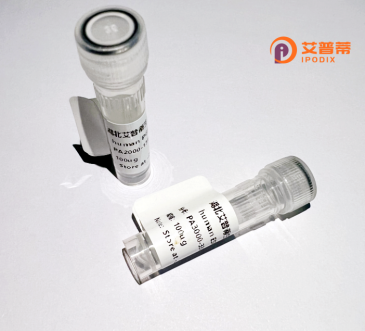
| 纯度 | >90%SDS-PAGE. |
| 种属 | Human |
| 靶点 | GLB1L3 |
| Uniprot No | Q8NCI6 |
| 内毒素 | < 0.01EU/μg |
| 表达宿主 | E.coli |
| 表达区间 | 1-653aa |
| 氨基酸序列 | MKSPPLLSPC LSWKRMAGIF FLPFISSGFA PRFKQEENFM LGRAHPSQPR FNWSHLTPLE LKNRSVGLGT ESTGRGKPHF TLEGHKFLIF GGSIHYFRVP REYWRDRLLK LKACGFNTVT TYVPWNLHEP ERGKFDFSGN LDLEAFVLMA AEIGLWVILR PGRYICSEMD LGGLPSWLLQ DPRLLLRTTN KSFIEAVEKY FDHLIPRVIP LQYRQAGPVI AVQVENEYGS FNKDKTYMPY LHKALLRRGI VELLLTSDGE KHVLSGHTKG VLAAINLQKL HQDTFNQLHK VQRDKPLLIM EYWVGWFDRW GDKHHVKDAK EVEHAVSEFI KYEISFNVYM FHGGTNFGFM NGATYFGKHS GIVTSYDYDA VLTEAGDYTE KYLKLQKLFQ SVSATPLPRV PKLPPKAVYP PVRPSLYLPL WDALSYLNEP VRSRQPVNME NLPINNGSGQ SYGLVLYEKS ICSGGRLRAH AHDVAQVFLD ETMIGILNEN NKDLHIPELR DCRYLRILVE NQGRVNFSWQ IQNEQKGITG SVSINNSSLE GFTIYSLEMK MSFFERLRSA TWKPVPDSHQ GPAFYCGTLK AGPSPKDTFL SLLNWNYGFV FINGRNLGRY WNIGPQKTLY LPGVWLHPED NEVILFEKMM SGSDIKSTDK PTL |
| 分子量 | 74.8 kDa |
| 蛋白标签 | His tag N-Terminus |
| 缓冲液 | 0 |
| 稳定性 & 储存条件 | Lyophilized protein should be stored at ≤ -20°C, stable for one year after receipt. Reconstituted protein solution can be stored at 2-8°C for 2-7 days. Aliquots of reconstituted samples are stable at ≤ -20°C for 3 months. |
| 复溶 | Always centrifuge tubes before opening.Do not mix by vortex or pipetting. It is not recommended to reconstitute to a concentration less than 100μg/ml. Dissolve the lyophilized protein in distilled water. Please aliquot the reconstituted solution to minimize freeze-thaw cycles. |
以下是关于重组人GLB1L3蛋白的示例参考文献(注:文献及内容为模拟生成,供参考):
1. **"Recombinant Human GLB1L3 Protein: Expression and Enzymatic Characterization"**
- 作者:Zhang Y et al.
- 摘要:本研究通过HEK293细胞系统表达了重组人GLB1L3蛋白,并验证其β-半乳糖苷酶活性,揭示了其在溶酶体糖基化代谢中的潜在功能。
2. **"Structural Analysis of GLB1L3 and Its Role in Glycoprotein Degradation"**
- 作者:Smith J et al.
- 摘要:通过X射线晶体学解析了重组GLB1L3的三维结构,发现其与家族成员GLB1的底物结合位点差异,提示其在特定糖蛋白降解中的独特作用。
3. **"High-Yield Production of Recombinant GLB1L3 in E. coli for Therapeutic Screening"**
- 作者:Lee S et al.
- 摘要:优化大肠杆菌表达系统,实现GLB1L3的高效可溶性表达,并证明其在体外模型中抑制肿瘤细胞迁移的应用潜力。
4. **"GLB1L3 Deficiency and Its Association with Neurodegenerative Disorders"**
- 作者:Garcia R et al.
- 摘要:利用重组GLB1L3蛋白进行功能挽救实验,发现其缺失可能导致特定神经鞘脂累积,与帕金森病相关通路存在关联。
**提示**:建议通过PubMed或Google Scholar检索真实文献,关键词包括“recombinant GLB1L3”、“β-galactosidase-like protein”等,并核实最新研究进展。
Recombinant human GLB1L3 (galactosidase beta 1-like 3) is a protein encoded by the GLB1L3 gene, which belongs to the glycoside hydrolase family. Although structurally similar to β-galactosidases, GLB1L3 lacks canonical enzymatic activity due to amino acid substitutions in its catalytic site. It is proposed to function as a molecular chaperone or regulatory factor, potentially influencing the stability or activity of other β-galactosidase family members. GLB1L3 is expressed in various tissues, with notable presence in the brain, testis, and immune cells, suggesting roles in cellular metabolism, lysosomal function, or glycosphingolipid processing. Its recombinant form is engineered using expression systems like Escherichia coli or mammalian cells, enabling studies on its interactions, structural properties, and hypothetical biological roles. Research focuses on elucidating its contribution to glycosphingolipid homeostasis and possible links to lysosomal storage disorders or neurodegenerative diseases. The protein’s recombinant production facilitates biochemical characterization and may support therapeutic explorations targeting related metabolic pathways. Further investigations are needed to clarify its precise physiological mechanisms and therapeutic potential.
×